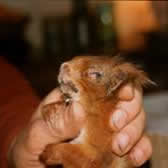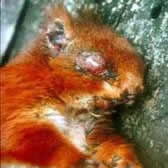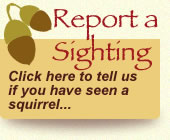The Squirrelpox Virus
The Squirrelpox Virus
The Squirrelpox virus is now the single largest threat to red squirrels in south Scotland. The disease is carried by the introduced grey squirrels but while it is harmless to them, it is lethal to our native red squirrels.
A red squirrel that contracts the disease will suffer from the following symptoms:
 |
|
 |
Red squirrels generally die within two weeks of contracting the disease.
If you have grey squirrels in your area and would like to help with grey squirrel control please contact us at RSSS via phone or email to join our Trap Loan Scheme.
See the Pox Virus Map to find out where seropositive grey squirrels have been detected.
The Squirrelpox Virus in Scotland
The pox virus was first identified as crossing the border from England into south Scotland in 2005 when pox carrying grey squirrels were detected just south of Newcastleton in the Scottish Borders. Grey squirrels that are carriers of the pox virus are referred to as being seropositive. In early 2006 seropositive grey squirrels were identified near Langholm in Dumfries and Galloway. Then in May 2007 came the news that all conservationists feared – Scotland’s first outbreak of the disease with red squirrel casualties identified from woodlands near Lockerbie. The newly appointed grey squirrel control officers responded rapidly to the outbreak with targeted grey control and an extensive search for further infected reds. The response was successful and the outbreak was contained.
The presence of seropositive grey squirrels in south Scotland has now, however, unfortunately increased dramatically. In 2008 the situation in south Scotland became gravely worse with the first disease outbreak of the year occurring in April on the Queensberry Estate near Thornhill. Just two months later further red squirrel casualties were detected in woodlands near Annan, Dalton and Langholm. The huge ‘leap’ of the disease from the Lockerbie/Langholm area to the Thornhill area came as a sad shock to all those involved with the geographic distribution of the 2008 outbreaks indicating that the disease was more widespread than previously thought.
Research shows that when pox is present the survival of red squirrels is reduced by a factor of twenty from the normal displacement and replacement rate of approximately 15 years. This means that seropositive grey squirrels could potentially replace local red squirrel populations in less than a year if left unchecked. By chance, only the grey squirrels introduced into England in 1876 carried the pox; those that were introduced into Scotland in 1892 were free of the virus, and it is for this reason that Scotland is still home to the majority of the UK’s red squirrels.
It is likely that the red squirrels known to have died from the Squirrelpox virus are only the tip of the iceberg as some squirrels will die in their dreys or away from visited areas and never be found. Research has indicated that it may be as little as 10% of red squirrel casualties that are actually detected. Work is in progress looking at a possible future vaccine and other aspects of the virus. The culmination of this research is, however, at least ten away but the red squirrels of Scotland need our help now if they are to survive. It is therefore imperative that grey squirrels carrying this disease into Scotland are controlled and the red squirrels are protected.
Click here for a printable version (pdf)

Please note this link will open a new window which will take you to the Scottish Wildlife Trust website where you can record your squirrel sightings.
Website by
Stewartry Technology





